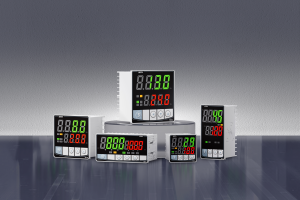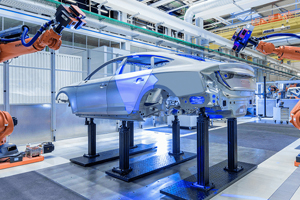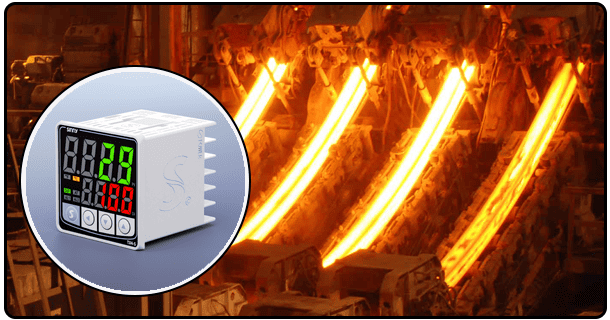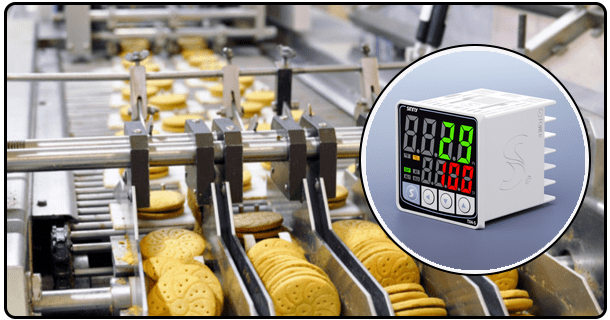Understanding PID water temperature controller
1. Introduction
The precise control of water temperature has a wide range of uses, from maintaining the critical temperatures in industrial processes to ensuring safety for heating systems. Basic thermostats are used to switch heating and cooling on or off. However, they often fall short in terms of accuracy, stability and efficiency. The Proportional-Integral-Derivative (PID) temperature controller represents a significant advancement in control technology. This sophisticated controller offers unmatched stability and responsiveness. The purpose of this article is to explain the PID controller in a comprehensive and clear manner. The article will explore the fundamental principles behind the PID algorithm. It will also describe the way the controller works within a heating system. Engineers, technicians, managers of facilities, and others who are involved with designing, maintaining or operating water heating systems that require consistent temperature control, need to understand the benefits and workings of PID controllers.
2. PID Control Algorithm - a Brief Description
The PID algorithm is at the core of the PID controller. It's a method widely used for controlling processes using feedback. PID is an acronym for Proportional Integral and Derivative. The three components act in synergy to reduce the gap between the setpoint (the desired temperature) and actual temperature measured by the sensor.
A. The Basic Principles for PID
Control (Proportional): This term produces an output signal that has a magnitude directly related to current error, i.e. the difference between setpoint and measured temperatures. The stronger the corrective action, the greater is an error. If the temperature of the water is lower than desired, then the proportional terms will send a strong signal to the heater, which calls for additional heat. In contrast, if temperature is close to setpoint then the contribution of the proportional terms is minimal. P-term's main advantage is that it reacts immediately to an error.
Integral Control (I): Addresses past errors. The integral term adds up the errors over time if the error is persistent. The controller will no longer make steady-state mistakes if it tries to adjust the temperature, but is unable to reach the setpoint because of system delays and minor disturbances. Imagine adding heat slowly if temperature consistently falls below target.
Control (D) Derivative: This term is used to predict future errors by analyzing the rate of change in the error. The derivative term calculates the change in temperature and produces an output which opposes that change. It is useful to dampen down the response of the system, prevent overshoots (where temperature exceeds the desired setpoint), and reduce oscillations. This term is used to apply a small amount of braking pressure when a heating system responds too rapidly or is on the verge of overshooting.
B. B. Why PID works for water systems:
Many water heating systems have characteristics such as thermal inertia, which is a storage of a lot of heat. They also respond slowly. A simple on/off thermostat can cause temperature fluctuations and the heating element to be turned on/off frequently. This is not efficient and uncomfortable. PID excels at managing this dynamic. The integral term eliminates residual errors and ensures accuracy over the long term. Finally, the derivative term smoothes the control action to prevent instability. PID controllers are therefore ideal for applications that require a constant water temperature.
C. Incorporate keywords like "PID Temperature Control", "Water Heating Control Logic", "PID Response", and "Temperature Regulation Algorithm" throughout this section.
3. The Key Components in a PID Temperature Control
The hardware that makes up a PID controller for water temperature must be able to work seamlessly. It is important to understand these components when selecting the system and for maintenance.
A. The controller unit is the CPU of the system. It's usually housed inside a rugged enclosure that can withstand industrial and environmental conditions. The controller can either be based upon a microcontroller, or a Programmable Logic Controller. The controller receives temperature input from the sensor and performs PID calculations. It then generates a signal that controls the cooling or heating element. Many modern controllers are programmable, which allows users to set up modes and control strategies.
B. The accuracy of the measurement is crucial. The selection of a temperature sensor is based on the range of temperatures, the accuracy needed, and even the type of water. Resistance Temperature Detectors, such as PT100 (known for its high accuracy and reliability), and thermocouples are common types of sensors used in PID controllers for water temperatures. RTDs, which have a wide range of temperature and durability but less precision, can be found. Sensors must be designed to ensure accurate positioning within the loop or for immersion into the water. It is important to calibrate the sensor regularly in order to ensure measurement accuracy.
C. Actuation output: The controller must be able to influence physically the cooling or heating process. This output acts as the link between electronic controller signals and final control devices. It could be a relay which switches an electrical circuit with high power to an electric heater. It could also be a signal of 4-20mA or a voltage signal 0-10V to control the input power to a heater element, or to regulate the speed or rotational rate of a connected pump. Some controllers are capable of modulating solid-state relays directly for smoother control.
D. The controller, and possibly the sensor as well, require an accurate and stable power supply. The main power (often AC voltage) is converted into DC voltages required by the circuitry of the controller. Power supply units must be protected from electrical noise and fluctuations.
E. It is possible to use optional Flow/Level sensors. In certain applications (especially those with heat exchangers or larger systems), knowing the flow rate of the water or liquid in the tank can be crucial for controlling the system. Flow meters and level sensors (such as ultrasonic, float or flowmeters) provide data that can be used by the PID control system to optimize the performance of the entire system.
F. Include phrases such as "hardware components for PID controllers," types of water temperature sensors, "actuation systems for heating systems," power supplies for PID controllers and flow sensors for water heaters."
4. What is a PID Water Thermostat Controller?
A PID controller for water temperature operates in a loop that is a constant cycle. This ensures the temperature of the water remains close to its setpoint and stable.
A. The control loop:
Measurement The temperature sensors continuously measure the water temperature, and transmit this information to the controller.
Comparison The controller compares the measured temperature (Process variable or PV) with the target temperature desired by the user. This difference is what we call the error.
Calculation : This error is processed by the PID algorithm. The PID algorithm calculates this error's contribution based on current and previous errors and configured gains.
Output By combining these inputs, the controller generates an output signal. The output signal will be sent to an actuation device, such as a modulating valve or heating element control relay.
Action When the signal is received, the actuation system adjusts its heating power or cooling force accordingly. The output signal will increase heating power if the error (temperature) is positive. The output signal will reduce heating power if the temperature is high.
Feedback Adjusted heating/cooling actions change the water temperature. Sensor measures new temperature and cycle continues, constantly correcting temperature.
B. Setpoints and modes: Users interact with the controller in order to select the desired temperature of the water (the setpoint). It may be possible to choose between different modes of operation. For example, the controller can offer continuous operation where it tries to keep the temperature constant, and scheduled operation where you program the desired water temperature to change on a specific schedule.
C. Response and stability: The PID is designed to give a stable reaction. The PID algorithm helps to reach the setpoint quickly, without significantly overshooting. It also prevents temperature oscillations around the target. The controlled and stable behaviour of the system is an advantage over simple on/off controls, which may lead to longer response times or temperature instability.
D. Search engine optimization focus: Include terms such as "PID process control", "water temperature loop control", "controller signal," PID heating system operation," proportional integral derivative," and "temperature stability".
5. Application of PID water temperature controllers
Water temperature controllers with PID technology are suitable for many applications in a wide range of industries.
A. Water is often used in industrial processes to heat, cool, or perform chemical reactions. In industries such as textiles, food processing, pharmaceutical production, chemical manufacturing and the manufacture of chemicals, precise temperature controls are often required for processes like washing, drying or cooking. The PID controllers provide the consistency necessary to ensure product safety and quality.
B. HVAC systems: In larger HVAC systems (heating, ventilation and air-conditioning), water is often used to distribute heat or cool (hydronic systems). The temperature of water is controlled by PID controllers in boilers and chiller plants to ensure that water delivered to radiators or systems for underfloor heating meets required temperatures. The overall comfort and energy efficiency of the building is greatly improved.
C. It is important to maintain a comfortable, hygienic temperature in spas and swimming pools. Although simple thermostats may be used to manage temperature, PID controllers provide a finer level of control. They allow for more consistent temperatures, quicker heating when necessary, and improved energy management. This leads to an increase in user comfort, as well as reduced operating costs.
D. For domestic hot water systems, in large commercial and residential environments PID controllers offer an advantage over simple thermostats when managing complex heating or hot-water tanks. PID controllers can provide a more consistent output and reduce energy consumption by not cycling the boiler as often. They also offer better recovery when there are multiple hot water demands at once.
E. The temperature of the cooling water is crucial for server longevity and reliability. The PID controller can regulate water temperature in data center cooling towers or chillers.
F. Keywords: Focus on specific applications using keywords such as "PID temperature controller for swimming pool", "PID temperature controller HVAC", "swimming temperature controller PID", "commercial hot-water PID system", "datacenter cooling water PID".
6. The Advantages of PID Water Temperature Control
Comparing PID controllers to other control methods, they offer several advantages that make them the best choice in demanding applications.
A. High Precision and Accuracy: The PID algorithms are exceptionally good at minimising the difference between the process variable and the setpoint. The water temperature remains very close to desired values, critical in processes that are sensitive to changes in temperature.
B. Stability and reduced overshoot. PID controls help stabilize system responses. This prevents temperature "overshooting", which can lead to oscillations and a chaotic heating/cooling process.
C. The PID controller can improve the efficiency of your heating and cooling systems by maintaining the temperatures more accurately, and avoiding big temperature fluctuations. It is possible to reduce energy usage by using a PID controller instead of simple thermostats.
D. PID Controllers are able to respond faster to system changes or changing load conditions. This allows the temperature of the water to be brought back up to setpoint more quickly than simple systems.
E. The potential for automation and integration: PID controllers that are networked can be easily connected to other systems and devices on the same network (e.g. SCADA, Building Management Systems, Data Loggers). Remote monitoring and automated control can be achieved by integrating the PID controllers into larger automated facilities.
F. Incorporate keywords that are benefit-oriented, such as: "stable temperature with PID control", "PID temperature control vs. on/off control", "PID water heater efficiency," "automation using PID controllers" and "energy-saving water heating PID".
7.PID controllers offer significant advantages, but their successful operation and implementation requires careful consideration of many factors.
A. It is important to consider the locati0n of your temperature sensor. Idealy, it should measure the temperature of the water in bulk that is being controlled by the cooling or heating system. It can be a bad idea to place it close to the heat source. This will give an inaccurate reading and lead to a control that is unstable. It is important to follow the manufacturer's guidelines, and consider the flow dynamics in the system.
B. PID tuning: A PID controller's performance is heavily dependent on the correct setting of its Proportional, Integral and Derivative gains. The tuning process involves changing these parameters in order to get the response you want - rapid heating/cooling with minimal overshoot and oscillation. It can be difficult and requires some experience. Some controllers have automated tune-up routines, or even graphical aids for tuning (such as the Ziegler Nichols method). However, manual tuning may still be required. PID controllers that are not tuned properly can cause unstable operation and fail to meet temperature requirements.
C. System Integration: To integrate the PID Controller into an existing water heater system, it is necessary to select compatible components such as sensors, actuators and power supplies. It also requires that the electrical and mechanical connections be made correctly. Always put safety first. This includes proper grounding, protection from electrical hazards and protecting against any other dangers.
D. Safety Features: A malfunctioning water heating system can be a safety risk. Safety features are essential for a reliable PID control. They could include alarms for high or low temperatures that warn the operator, shutdowns if the temperature exceeds safe levels, or safeguards in case of sensor failures. It is important to comply with safety standards.
E. Use keywords like "PID calibration process", "sensor placement in water heating PID", "integrating PID into HVAC", "PID safety features", "water heating systems implementation", and "PID configuration".
8. The PID controller is a sophisticated and powerful solution to achieve precise and stable temperature control. By leveraging the Proportional-Integral-Derivative control algorithm, these controllers effectively manage the inherent complexities of water heating systems, offering significant advantages over simpler control methods. They are used in many critical applications. From industrial processes to HVAC systems, swimming pools to data centers, their ability to deliver high accuracy, stability and energy efficiency makes them indispensable. The benefits of a successful implementation often outweigh any initial investments. This includes sensor placement, tuning PID, and integration with the system. The PID controller is a key technology that ensures optimal conditions in countless systems and processes.
8. Bibliography & Additional Reading
The following resources provide additional information on water temperature controls and PID controllers.
A. A. Manufacturer Websites. Reputable manufacturers (e.g. Siemens, Rockwell Automation Schneider Electric, Delta Controls), offer product details, manuals and applications notes. Their websites provide examples of PID temperature controllers and their technical specifications. You can search for Siemens PID water temperature controller or Rockwell Automation PID control of water heating.
B. Blogs and technical articles: Websites and publications focusing on process automation and control engineering often include articles that discuss PID theory and tuning techniques as well as application case studies relating to temperature and water heating. Start with websites like Control Engineering. Automation World. Industrial Automation Times. and Engineering.com. You can search for "PID tuning of water heating Control Engineering", "Ethernet-enabled PID controller Applications Automation World", etc.
C. Standardization: Standards may be needed depending on industry or application. Organisations such as the International Electrotechnical Commission publish standards relating to sensors and control systems (e.g. IEC 61131-3, for programming PLC). HVAC standards organizations (like ASHRAE), may publish guidelines for water temperature control within building systems. Search for "IEC 61131-3 water temperature control" or "ASHRAE Standards PID Control".
D. Education Institutions: University with a strong engineering program often publishes papers and conducts research on thermal and control management. You can find technical articles by visiting departmental websites or accessing databases. You can search for "university PID temperature control" (for example).
Note: This section will contain URLs or citations of the source(s) that were used in a finished article.
- Explore the basics of PID Temperature Controllers and how they function
- The PID temperature controller with Ethernet: Benefits and Features























